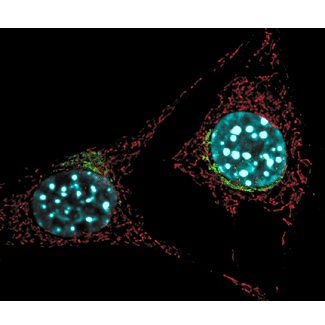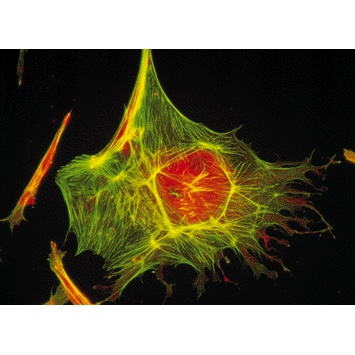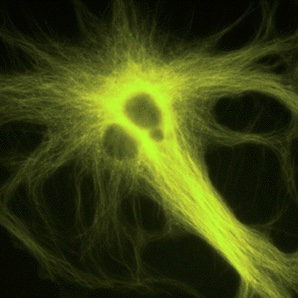All living things are made up of cells. Some organisms, such as bacteria, may exist solely as single-celled creatures. Others, including humans, are comprised of countless cells all working together to form a single living being. Humans are comprised of trillions of cells that are organized into tissues such as muscle and skin or organs like the liver or lung. The animation below depicts the relationship between an organ (the liver) and the cells from which it is constructed. The final image is a close-up view of a single cell.
The proper function of human bodies is dependent on smaller structures, or organs, such as the heart or lungs. The tiny cells that make up these organs actually contain within them smaller structures called organelles. These organelles help the cells to perform their jobs. In cancer, changes to these organelles can cause the individual cells and ultimately the entire organism to have serious problems. To get a better understanding of how cells work, we will now spend some time examining some of these subcellular structures.
The organelles that we will discuss are involved in the information flow within cells and in energy production. In addition, we will look at a structure that gives cells their shape and allows them to reproduce themselves. All of the organelles and processes to be discussed have direct relevance to cancer because these are the cellular structures/activities that become disturbed in the disease.
The image below shows two living mouse cells. The mitochondria are colored red and the nuclei (with brightly stained chromosomes) are colored blue. The green colored region near the nuclei of the cells represents the golgi apparatus, an organelle involved in the processing and packaging of molecules within the cell.

The image above was used with the permission of the copyright owner, Molecular Probes.
Further information on the topics on this page can also be found in most introductory Biology textbooks, we recommend Campbell Biology, 11th edition.1
The organelles responsible for maintaining proper cellular function are described in the following sections:
- Organelles Overview
- Nucleus
- Mitochondria
- Ribosome
- Cytoskeleton
- Cell Structure Summary Sheet
- Interactive Game: Know the Flow
Organelles Overview
The functions performed in the body are divided up and performed by different organs and tissues. Food is digested in the stomach and intestines, bones provide structure and strength, and the brain acts as a central location for processing information and issuing commands to other parts of the body.
In much the same way, the functions of individual cells are divided amongst well organized combinations of biomolecules. These structures are analogous to the organs in the body and are called organelles.
The organelles are suspended in a viscous water-based liquid. The fluid is known as the cytosol. The fluid and the organelles that are located outside the nucleus are collectively called the cytoplasm. The cytoplasm of a cell is highly organized and the positions of the organelles actively controlled.
View the image below to get a brief description of the functions of some of the organelles present in a typical cell.

Nucleus

The nucleus can be thought of as the brains of a cell. Our genetic material (DNA), in the form of chromosomes, is stored in this organelle. The nucleus (plural-nuclei) is roughly spherical and is surrounded by two membranes. As stated in the previous chapter, cellular membranes are made up of two sheets of lipids facing one another.
As shown above, the nucleus is home to chromosomes. Chromosomes are composed of long strings of DNA. As shown in the animation below, the DNA in a chromosome is highly organized and looped. The X shaped chromosome shown in the two animations on this page actually represents a chromosome that has been copied or replicated in preparation for cell division. An unreplicated chromosome consists of a single DNA molecule which can contain thousands of genes. The DNA in chromosomes acts as a kind of blueprint to guide all of the other activities in the cell.
Some key features of our genetic make-up:
- We have two sets of chromosomes; one contributed by each parent via the gamete (sperm or egg). Human cells normally contain 46 chromosomes, 23 from each parent.
- Chromosomes are made up of a complex between DNA and proteins. This complex is called chromatin.
- Genes are sections of DNA that contain the information for the production of a specific molecule such as a protein. Important in the development of cancer, small changes in the nucleotide sequence of a gene may result in the altered behavior of a cell.
Changes to the genetic material are essential for the development of cancer.
Mitochondria
Mitochondria (singular- mitochondrion) are the energy powerhouses of cells. Much of the energy that cells (and therefore individuals) require to function is harvested from biomolecules such as sugars and fats obtained from food. Mitochondria carry out the final steps of converting the food to energy. Like the nucleus, mitochondria are surrounded by a double membrane.
Like the burning of gasoline in an automobile engine, the energy production process is not completely efficient and produces by-products that often have undesirable effects. Energy production in mitochondria leads to the production of chemicals that may damage DNA and therefore cause genetic changes. These dangerous side products are thought to contribute to the mutations seen in cancer cells.
A diagram of a mitochondrion, showing the two separate membranes and the inner compartment that is the site of energy production is shown below.

In the image below, the mitochondria in mouse cells have been stained red. The nuclei and chromosomes of the cells are blue. Note the wide distribution, large number and the somewhat irregular shapes of the mitochondria. The green regions near the nucleus in each cell are organelles known as the golgi apparatus, they are involved in the modification and shipment of biomolecules such as proteins.

The image above was used with the permission of the copyright owner, Molecular Probes.
Ribosome
Ribosomes are made up of two large complexes comprised of RNA and protein. Ribosomes are located in the cytosol and are quite numerous. They are responsible for reading RNA and using the encoded information to produce proteins in a process called translation. Translation is discussed in more detail in the Gene Function section.
The diagram below shows the two ribosomal subunits (large and small) bound to a messenger RNA (mRNA).

Cytoskeleton
The cytoskeleton is an intricate network of proteins that criss-cross the cytoplasm of cells. The cytoskeleton is composed of a wide variety of proteins. These proteins often form long twisted strands that look like electrical wire or the cables used to hold up bridges. Like these man-made components, the proteins that make up the cytoskeleton are both strong and flexible.
A main fiber type, actin, is made up of long strings (polymers) of the protein actin. The image below shows the actin fibers in a cow endothelial (blood vessel) cell. The yellow colored strings are the polymerized form of the protein and the red color indicates the presence of the single protein units.

Another critical cytoskeletal fiber is the microtubules. They are also polymers, and are comprised of the protein tubulin. The image below shows the microtubules in a cow endothelial cell.

As can be seen from the images above, the cytoskeleton is distributed extensively throughout cells.
The images on this page were used with the permission of the copyright owner, Molecular Probes..
Cytoskeleton Function
The image below shows both the actin fibers (in red) and microtubules (in yellow) in cow endothelial cells. The nuclei of the cells have been stained blue.

The cytoskeleton serves several key functions:
- It supplies structure to cells and acts as a scaffolding for the attachment of many organelles.
- It is responsible for the ability of cells to move.
- It is required for the proper division of cells during cellular reproduction.
As we will see, changes in the cytoskeleton are observed in cancer cells. Cancer cells often show increased movement. In fact, metastatic spread of cancer is dependent on tumor cells that invade neighboring tissues.
The essential role of the cytoskeleton in the proliferation of cells has led to the use of drugs that inhibit the cytoskeleton as anti-cancer drugs. Examples of drugs that interfere with cytoskeletal function include Taxol® and vinblastine.
More on cytoskeletal inhibitors in cancer treatment.
The image on this page was used with the permission of the copyright owner, Molecular Probes.
Cell Structure Summary Sheet
Organelles
- Organelles are structures that carry out different functions within a cell.
- Organelles in a cell are analogous to the organs in a body.
- Organelles are suspended in a water-based fluid called cytosol.
The Nucleus
- The nucleus stores the genetic information (chromosomes) of eukaryotic cells.
- The nucleus is roughly spherical and is surrounded by two membranes.
- The nucleus is the 'brain' of a cell.
The Mitochondrion
- Mitochondria are the power houses of a cell.
- Mitochondria convert biomolecules (i.e. fats and sugars) into energy.
- By-products of energy production in mitochondria may damage DNA and cause mutations.
The Ribosome
- Ribosomes are made up of two large complexes comprised of RNA and protein.
- Ribosomes are located in the cytosol. Their function is to read RNA and produce proteins in a process known as translation.
The Cytoskeleton
- The cytoskeleton is an intricate network of proteins that criss-cross the cytoplasm of a cell.
- Actin and tubulin are the proteins used to build main fibers of the cytoskeleton (microfilaments and microtubules, respectively).
- The cytoskeleton serves several key functions:
- Provides structure to cells and a place to anchor organelles
- Cell motility
- Control of cell division during mitosis
- Changes in the cytoskeleton that allow increased movement are observed in cancer cells.
- Many anti-cancer drugs work by interfering with the activity of cytoskeletal proteins.
Know the Flow
Know the Flow is an educational game for you to test your knowledge. To play:
- Drag the appropriate choices from the column on the right and place them in order from smallest to largest in the boxes on the left. Note that you will only use five of the six choices to complete the game.
- When done, click on 'Check' to see how many you got correct.
- For incorrect answers, click on 'Description' to review information about the processes.
- To try again, choose 'Reset' and start over.
Please visit us on a larger screen to play this game.
If you find the material useful, please consider linking to our website
- 1 Further information and the topics on this page can also be found in most introductory Biology textbooks, we recommend Campbell Biology, 11th edition.
